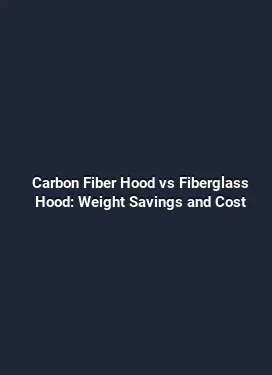Best Lexan Window Installation for Weight Reduction in Race Cars
Achieving lower weight without compromising safety or visibility is a perpetual objective in race car engineering. Lexan, a polycarbonate thermoplastic, has become a staple for side and rear window applications due to its high impact resistance, light weight, and optical clarity. This article delves into the practical aspects of selecting the right Lexan material, shaping it for minimal mass, mounting strategies that preserve rigidity, and the aerodynamic considerations that accompany a lighter cockpit. The discussion moves beyond generalities to provide actionable steps, precise measurements, and real-world examples that teams can apply on the workshop floor.
Material Fundamentals: Why Lexan Outperforms Glass in Racing Environments

Lexan is favored in race car closures because it delivers a combination of toughness, resilience, and modularity that conventional glass cannot match at a similar weight. In racing scenarios, the window must withstand flying debris, rapid temperature changes, and potential impact from trackside incidents. Lexan’s impact resistance is substantially higher than automotive glass, reducing the risk of catastrophic shattering. The material also enables thinner profiles without sacrificing strength, which translates directly into weight savings per window assembly.
When evaluating Lexan grades, it is essential to consider optical clarity, UV resistance, and chemical compatibility with common cockpit environments. For example, Lexan 9030 or 2407 grade families often provide a balance between surface hardness and light transmission suitable for primary and secondary windows. A critical property is the material’s Vicat softening point and elongation at break, which influence how the sheet behaves under heat during high-speed operation and sustained sun exposure. For weight-conscious builds, engineers frequently specify thinner gauges, such as 3/16 inch (approximately 4.8 mm), with careful edge finishing to preserve both strength and visibility.
In addition to the base material, consider coatings and treatments that enhance durability without adding significant mass. Anti-scratch coatings reduce surface wear from wiper action and cleaning solvents, while UV stabilizers slow yellowing from prolonged sun exposure. A durable exterior protective layer can extend service life in environments where track debris, stone strikes, and high-speed airflow are constant factors. Each additional coating should be weighed against its incremental mass, but modern coatings are typically lightweight and contribute minimal mass while delivering meaningful longevity gains.
Edge Design and Geometry: Optimizing for Lightness

Edge geometry plays a pivotal role in both safety and weight distribution. A clean, radiused edge reduces stress concentrations that could lead to crack initiation during impact or thermal cycling. Mortise-and-tenon style frameless installations require precise routing and chamfering to ensure an airtight seal with minimal gasket thickness. By eliminating unnecessary thickness at the edges, teams can shave additional grams without compromising structural integrity. In high-performance configurations, engineers may opt for laser-cut edges to achieve repeatable tolerances across multiple units, ensuring consistent mass and fit across a fleet of vehicles.
Installation Techniques: From Cutting to Mounting
Installation quality is a major determinant of weight performance. Precision cutting, proper edge finishing, and robust fastening methods collectively determine how effectively a Lexan window contributes to weight reduction without sacrificing safety. The following subsections outline practical steps and considerations.
Cutting and Mitering: Achieving Accurate Fits
Begin with a precise template derived from the dedicated window opening. Use a sharp carbide router bit or a high-quality jigsaw with a fine-tooth blade to minimize material chipping. A pneumatic or electronic oscillating tool can help achieve gentle curves around complex openings. Maintaining consistent thickness around the perimeter is essential, so measure across several points to confirm flatness and uniformity. A light scoring pass before a full cut reduces the risk of stress cracks and ensures a clean edge ready for finishing touches.
Deburring and edge finishing are critical for seating and sealing. Deburring removes micro-burrs that can act as initiation sites for cracks under load, while a controlled chamfer can improve gasket seating. For race applications, a small radius on interior corners helps distribute stress more evenly. After cutting, perform a thorough inspection of the edges under a bright light to detect any nicks or irregularities that could affect the seal or aerodynamics.
Fastening Systems: Securing Weight Without Adding Bulk
Fastener selection is a major lever in overall mass management. Lightweight fasteners such as titanium or high-grade aluminum alloys offer substantial mass reductions compared to traditional metal hardware, especially when used in low-friction, high-stress zones. The mounting hardware should provide a secure, vibration-resistant connection that maintains the window’s position across the full range of dynamic loads encountered on track. Quick-release mechanisms can simplify maintenance while preserving safety if they are designed to remain fail-safe under crash or emergency scenarios.
Edge seals and gaskets contribute to both sealing performance and mass. For Lexan windows, vulcanized or EPDM elastomer gaskets around the perimeter provide an effective barrier against wind noise, water intrusion, and debris ingress. Engineers often experiment with gasket thickness to balance sealing performance with window weight; in many setups, a gasket in the 2–3 mm range offers a favorable compromise. Adhesive bonding, mechanical fasteners, and hybrid attachment strategies are common, with the choice dependent on opening shape, expected loading, and ease of replacement during maintenance windows.
Aerodynamic Implications: How a Lighter Window Shapes the Airflow
Weight reduction in the cockpit has cascading effects on the vehicle’s inertia and the way air flows around the body. A Lexan window, especially when flush-mounted and properly contoured, can reduce drag and alter the pressure distribution at the door line and roof region. Key aerodynamic considerations include surface finish, edge clearance, and the interaction between the window and adjacent panels. A smooth, mirror-like Lexan surface minimizes boundary layer separation at high speeds, contributing to a more laminar flow over the cockpit area and reducing turbulent wake behind the A-pillar.
To capitalize on these benefits, designers often align the Lexan window with a carefully shaped window frame that maintains a gentle transition from the window to the surrounding bodywork. If the window employs a frameless or semi-frameless design, attention to adhesive bead geometry and flange surface finish becomes critical. Achieving a consistent gap profile around the entire periphery helps maintain predictable airflow and reduces parasitic drag. Dynamic testing, such as wind tunnel or on-track data collection, can quantify how small changes in window geometry influence drag coefficients and stability at various yaw angles.
Sealing and Aerodynamic Fairing: Integrating with the Body
Affixing Lexan windows in a way that minimizes turbulence involves careful sealant selection and fairing integration. The seal must withstand heat, vibration, and exposure to track solvents while remaining lightweight. Advanced sealants with low durometer ratings can improve seating without adding excessive mass, provided they cure to a stable mechanical bond. Fairings adjacent to the window should be designed to blend in with the cockpit side pods or door panels, smoothing the transition and preventing stagnant eddies that can increase drag or cause lift at the edge of the window.
Performance Validation: Testing Weight Savings and Aero Effects
Quantifying the impact of Lexan installations requires a combination of static and dynamic tests. Weigh each window module precisely, accounting for the sheet, gaskets, fasteners, and any coatings. Subtract these figures from the corresponding glass-based configurations to determine real-world mass savings. In addition to weight, confirm optical clarity and distortion under load by performing a controlled in-cockpit visibility assessment at different angles and lighting conditions. A window’s thickness, coating, and mounting stiffness can influence glare and perceived brightness, which in turn affects driver fatigue and reaction times during a race.
From an aerodynamics perspective, collect data on pressure distribution along the cockpit boundary layer and measure drag changes with different window finishes and seal profiles. If possible, implement a small-scale model or CFD-based evaluation to visualize airflow around the window edge. Use the findings to refine edge radii, gasket thickness, and fairing shapes for optimal balance between weight savings and aerodynamic efficiency. Real-world testing should always be complemented by careful documentation of material behavior under track conditions, including thermal expansion, optical performance, and impact resistance after repeated loads.
Maintenance, Durability, and Lifecycle Considerations
Maintenance planning is essential to preserve weight advantages over multiple seasons. Regular inspection cycles should include checks for micro-cracks along edges, delamination around adhesive bonds, and surface crazing caused by UV exposure or temperature cycling. Cleaning routines should employ non-abrasive microfiber cloths and mild cleaners that do not degrade coatings or gaskets. In high-debris environments, the protective coating might require periodic reapplication, which should be scheduled to avoid compromising sealing performance or adding unexpected mass during replacement intervals.
Lifecycle analysis of Lexan windows considers replacement intervals driven by scratch resistance, impact history, and thermal aging. In professional racing, window assemblies are often designed with modular components so that a damaged pane can be replaced without removing the entire window frame. This modularity reduces downtime and ensures that the weight balance of the cockpit remains consistent when replacements are performed. By maintaining consistent hardware and gasket inventories, teams can minimize error-induced weight variations and preserve repeatable performance characteristics across events.
Practical Guidance: A Step-by-Step Implementation Plan
For teams pursuing a measured approach to Lexan window implementation, the following step-by-step plan provides a practical framework that aligns with performance goals and reliability standards.
- Define target weight reduction for each window, including all associated components, and document a baseline from the current setup.
- Specify Lexan grade, thickness, and any coatings based on operating temperatures, exposure conditions, and optical requirements.
- Create precise cut templates using the actual door openings, ensuring tolerances are within ±0.5 mm to maintain a consistent seal.
- Choose fastening hardware with weight-conscious materials and high-strength ratings; verify compatibility with sealing systems and frame geometry.
- Fabricate windows with careful edge finishing and radii to minimize stress concentrations and improve seating stability.
- Assemble with lightweight gaskets and verify seal integrity at operating temperatures and wind pressures encountered on track.
- Conduct static mass measurements and record the final assembled weight for each window configuration.
- Perform wind tunnel or track testing to observe aerodynamic effects and quantify drag and lift variations due to the new window setup.
Throughout the process, maintain meticulous documentation of materials, measurements, and test results. This data-driven approach enables teams to iteratively refine the installation for optimal weight, safety, and performance gains. It also facilitates easier compliance checks with class regulations and safety standards, ensuring that the Lexan solution remains repeatable and predictable across seasons.
In practice, many racing programs pair Lexan windows with related lightweight cockpit upgrades, such as reduced-frame sun visors or integrated venting solutions, to complementary effect. By coordinating changes across the cockpit and bodywork, teams can realize cumulative performance improvements without introducing disproportionate mass elsewhere. The goal is a cohesive system where every gram saved in the window assembly contributes to a tangible reduction in rolling inertia, improved acceleration response, and more predictable handling characteristics under high-speed braking and cornering loads.
Finally, always ensure that the final installation adheres to the sport’s safety standards and that the driver’s visibility remains uncompromised during critical maneuvers. A well-executed Lexan window strategy integrates with the vehicle’s overall aero balance, weight distribution, and structural resilience, delivering sustained competitive advantages on the track.






